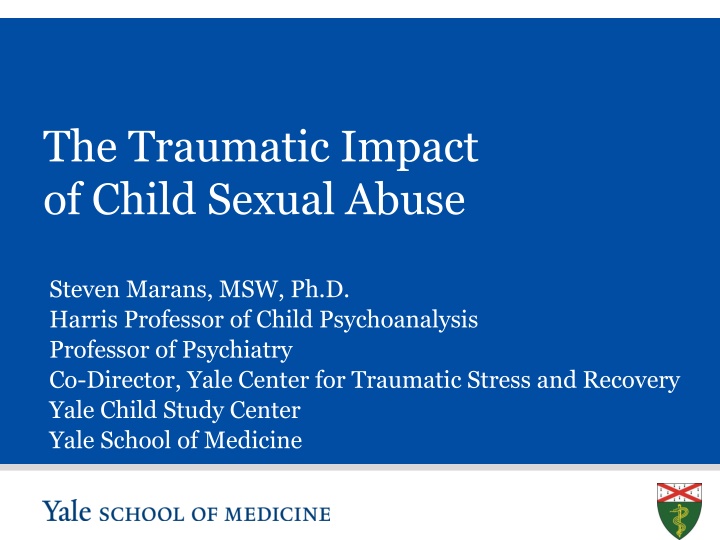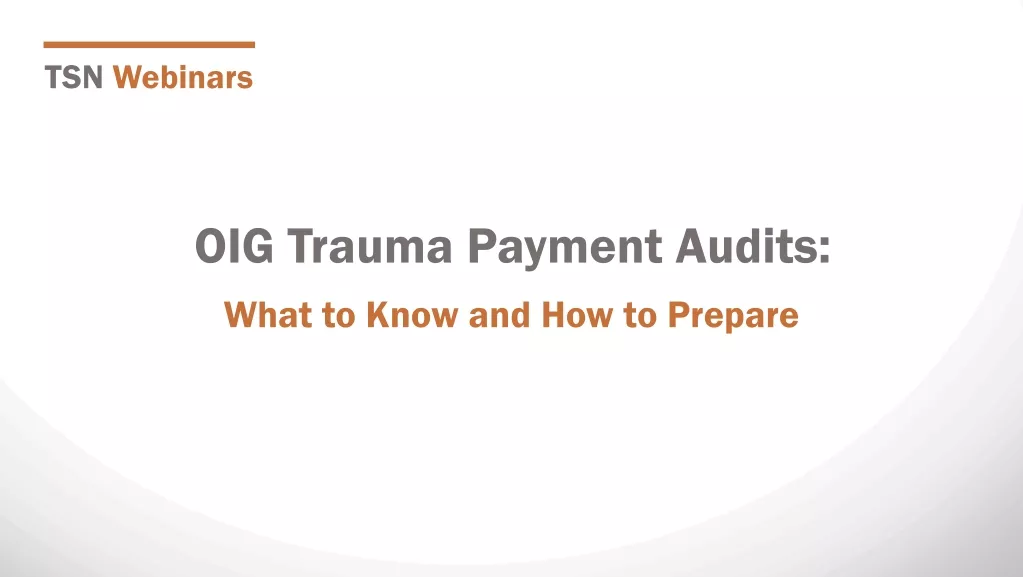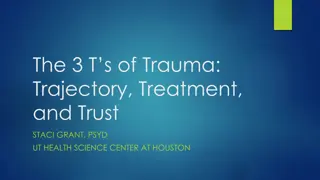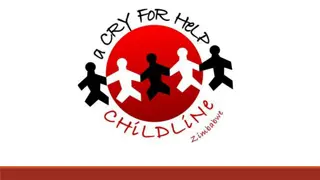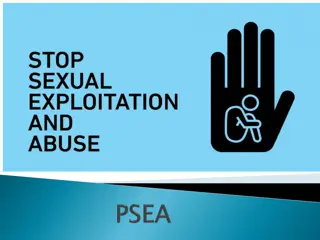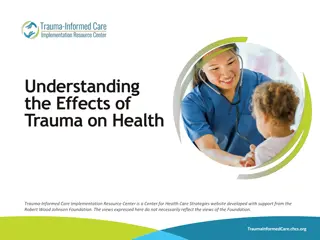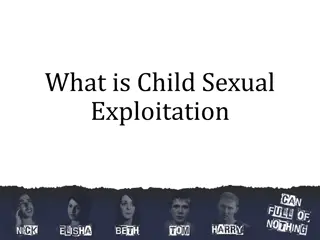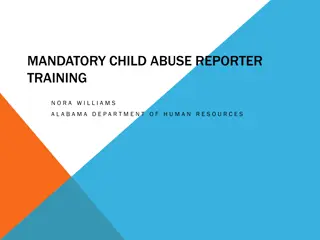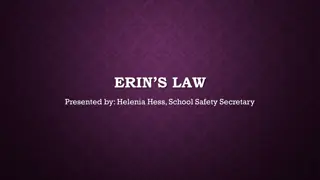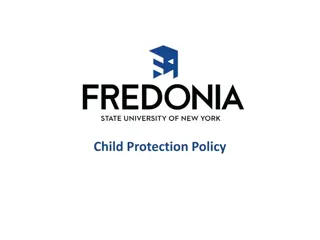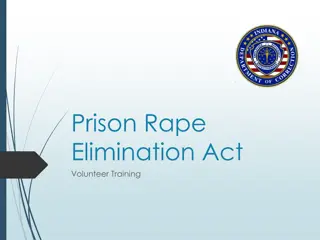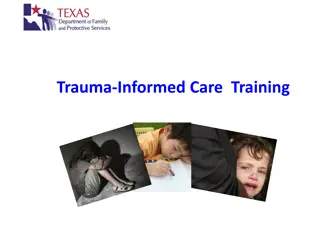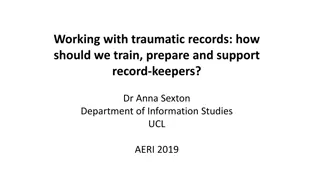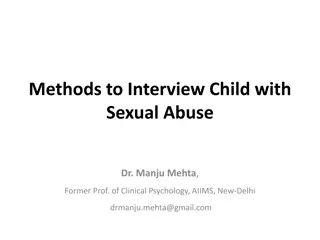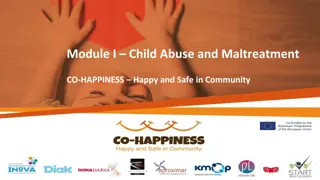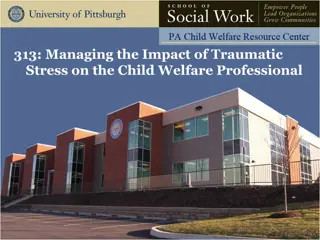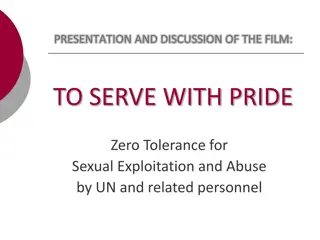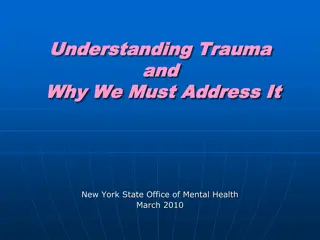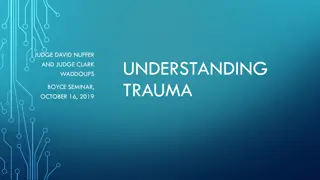The Traumatic Impact of Child Sexual Abuse: Sources, Psychological Trauma, and Brain Functioning
In this insightful content, Steven Marans delves into the traumatic impact of child sexual abuse, exploring sources of danger, psychological trauma as injury, and the effects on brain functioning. The narrative uncovers the overwhelming experiences faced by victims, the disruption in communication between brain regions, and the resultant activation of fight-flight responses. Through detailed analysis, the presentation sheds light on the intricate ways in which trauma manifests and influences individuals at a psychological and neurobiological level.
Download Presentation

Please find below an Image/Link to download the presentation.
The content on the website is provided AS IS for your information and personal use only. It may not be sold, licensed, or shared on other websites without obtaining consent from the author.If you encounter any issues during the download, it is possible that the publisher has removed the file from their server.
You are allowed to download the files provided on this website for personal or commercial use, subject to the condition that they are used lawfully. All files are the property of their respective owners.
The content on the website is provided AS IS for your information and personal use only. It may not be sold, licensed, or shared on other websites without obtaining consent from the author.
E N D
Presentation Transcript
The Traumatic Impact of Child Sexual Abuse Steven Marans, MSW, Ph.D. Harris Professor of Child Psychoanalysis Professor of Psychiatry Co-Director, Yale Center for Traumatic Stress and Recovery Yale Child Study Center Yale School of Medicine S L I D E 0
Sources of danger: Shared human fears Loss of one s own life Loss of the life of a significant other Loss of love of another or of oneself Damage to the body Loss of control of impulses, affects and thoughts Loss of control of sense of agency S L I D E 1
Psychological Trauma as Injury Overwhelming experience of danger and threat to physical and/or psychological integrity that leads to: decreasing danger and anxiety (fight, flight or freeze) Neuro-physiological dysregulation that compromises affective, cognitive and behavioral responses to stimuli Loss of control, feelings of helplessness, confusion Immobilization of usual methods for S L I D E 2
Impact of Trauma on Brain and Functioning Under normal circumstances: Regular communication occurs between pre-frontal cortex and amygdala Pre-frontal cortex: Organizes information Thinks in organized way Makes decisions about actions Amygdala: Acts as the center of the chemistry of emotions Plays a central role in responding to fear and threat Triggers fight-flight response S L I D E 3
Impact of Trauma on Brain and Functioning, cont d Communication between pre-frontal cortex and amygdala is disrupted when we feel threatened by: Threats to our own safety and the safety of others Major disruptions to the ways we live At these times, our brains literally may not work the same way When communication is disrupted: Fight-flight responses are activated Stress reactions are amplified Activation of fight-flight responses lead to: Increased production of stress hormones Increased physical and cognitive symptoms of anxiety and distress S L I D E 4
Impact of Trauma on Brain and Functioning, cont d When stress levels are high: Physical symptoms increase Ability to use thinking as a way of calming ourselves and take control decreases When the amygdala is working overtime: The prefrontal cortex, which organizes thoughts, analyzes problems, and initiates action plans, can be overwhelmed Very real changes in our ways of thinking occurs These changes in physical and cognitive symptoms can: Further activate our alarm systems Magnify sense of loss of control and helplessness Result in not our only the world feeling out of control, our but reactions and feelings seem out of control as well. S L I D E 5
Post-traumatic Symptoms Four major symptom areas: Re-experiencing Avoidance Hyper-arousal Negative alteration in cognition and mood S L I D E 6
Post-traumatic Symptoms Re-experiencing: Traumatic reminders Intrusive memories Traumatic play and re-enactment Nightmares Flashbacks and dissociation Distressed when reminded Somatic complaints and discomfort S L I D E 7
Post-traumatic Symptoms Avoidance: Actively avoids thinking or talking about event Avoids reminders of event (people, places, and things) Impaired recollection or memory New fears (e.g., separation, being alone, darkness, strangers) Sense of a foreshortened future or impending doom S L I D E 8
Post-traumatic Symptoms Hyper-arousal: Nightmares Difficulty falling or staying asleep Decreased attention or concentration Hyperactivity Irritability and changes in mood Increased aggression Hyper-vigilance and exaggerated startle response S L I D E 9
Post-traumatic symptoms Negative alterations in cognition and mood Interference with memories of traumatic events Negative beliefs about oneself, others, or the world Self-blaming Diminished interest in significant activities. Feelings of detachment or estrangement from others. Persistent inability to experience positive emotions S L I D E 10
Long-term Consequences Without recognition, support and treatment early traumatic reactions can persist and interfere with optimal development result in long-term deleterious outcomes Examples of long-term impact of unresolved trauma: PTSD Depression Anxiety disorders Dissociative symptoms Substance misuse Re-victimization Chronic health problems Early entry into unstable and poorly functioning relationships Personality disorders The inability to recover from trauma can result in higher rates of chronic psychosocial, psychiatric and physical health difficulties including: S L I D E 11
What Is Sexual Abuse? Sexual abuse is: Child sexual abuse is any interaction between a child and an adult in which the child is used for the sexual stimulation of the perpetrator or an observer. Sexual abuse can include both touching and non- touching behaviors. Non-touching behaviors can include voyeurism, exhibitionism, or exposing the child to pornography. - National Child Traumatic Stress Network S L I D E 12
Sexual Abuse Is Especially Traumatic Child sexual abuse is well recognized as one of the most powerful, significant traumatic experiences for children (DeLillo et.al., 2006; Finkelhor (multiple citations); ACE studies) Child sexual abuse is especially traumatic because of four unique traumagenic dynamics: Traumatic sexualization Betrayal Powerlessness Stigmatization (Finkelhor, 1985) S L I D E 13
How Does Sexual Abuse Impact Children? Sexual abuse is an experience that the child is developmentally unequipped to comprehend or process (Cook, et.al., 2017) When child sexual abuse goes unrecognized: There is an absence of family and social supports There is an absence of treatment Children are left on their own to deal with the traumatic dysregulation that ensues Symptoms of traumatic dysregulation that regularly follow the experience of sexual abuse: Can become chronic adaptations that can compromise unfolding development Can have profound negative outcomes over the lifespan S L I D E 14
Delayed disclosure Multiple studies indicate that delayed disclosure of child sexual abuse is very common: Estimated that 86% of child sexual abuse goes unreported (USDOJ) 60-70% of child sexual abuse survivors do not disclose until they are adults (Lemaigre, et.al., 2017) National survey of 4339 adolescents with 65% of girls, 23% boy, 59% had not disclosed their sexual abuse prior to the survey (Preibe&Svedin, 2008) A majority of adults who were victims of child sexual abuse indicated that they did not disclose their abuse as children (London, et.al., 2005; 2008) Average age of disclosure of child sexual abuse: 52 years (USDOJ, 2003) S L I D E 15
Factors that interfere with disclosure Difficulties in understanding, let alone verbalizing experiences of abuse, including recognizing that they have been abused (Kolko, 2002; van der Kolk, 2005; Teicher, et.al., 2016) Threats of violence and emotional consequences of breaking secrecy pact especially when perpetrator is family member or trusted figure Survivor s ambivalent feelings toward abuser Potential risk to attachment and care especially when abuser is a caregiver or family member Self-blame vs. blaming abuser for the abuse and resultant confusion about who is responsible S L I D E 16
Factors that Interfere with Disclosure Shame and guilt Post-traumatic defensive avoidance, dissociation and impact of depression and anxiety Perceptions of self as bad and unworthy as a result of experience of loss of control (Fonagy, 2002; Kim & Cichetti, 2006; Finkelhor & Omrod, 2010) S L I D E 17
Implications Too many children remain isolated, as they struggle to deal with the traumatic impact of their sexual abuse experiences For many, they are not only robbed of the most fundamental control of their bodies, and the confidence of trust in adults upon whom they rely For too many children, the consequences of unresolved traumatic experience also rob them of their optimal developmental potential that can reverberate throughout their adult lives When survivors of child sexual abuse remain unrecognized and unheard, the injustice and injury of their original traumatic experiences are only revisited and perpetuated in their adult lives S L I D E 18
Risk/Protective Factors Failure to recognize post- traumatic distress Absence of social/family support S L I D E 19
Supporting recovery Early identification Increased public awareness Clinical interventions S L I D E 20
Child and Family Traumatic Stress Intervention (CFTSI) Brief (5-8 session) evidence-based early intervention model for children that is implemented: After recent exposure to a potentially traumatic event After recent disclosure of earlier sexual or physical abuse Children aged 7-18 years old S L I D E 21
CFTSI Treatment Applications Children in foster care/ out- of-home placements Young children (3-6 years old) S L I D E 22
Goals of Early Intervention Improve Reduce Assess Improve screening and initial assessment of patients impacted by traumatic stress Reduce traumatic stress symptoms; interrupt and prevent chronic PTSD and related disorders Assess patient s need for longer- term treatment Serves as structure approach to assessment Can act as a seamless introduction to longer-term treatment if deemed necessary S L I D E 23
CFTSI Results Significant decrease in child s trauma symptoms Significant decrease in caregiver s trauma symptoms Increase in Child- Caregiver Communicati on Children Who Received CFTSI Were 65% Less Likely to Meet Full Criteria for PTSD Children Who Received CFTSI Were 73% Less Likely to Meet Partial or Full Criteria for PTSD 62% of caregivers who participated in CFTSI experienced clinically meaningful improvements in post-traumatic stress symptoms CFTSI increases shared caregiver/ child report of posttraumatic symptoms Significant decrease in discrepancy in child and caregiver reporting on child s trauma symptoms S L I D E 24
Change in Child Trauma Symptoms Child (N=161) and Caregiver (N=165) Reported CPSS Scores Pre/Post CFTSI 25 20 15 20.81 10 12.78 5 8.73 6.72 0 Child Pre-CPSS Child Post-CPSS Caregiver Pre-CPSS Caregiver Post-CPSS S L I D E 25
Change in Parent-Child Communication Discrepancy in Child and Caregiver Reported CPSS scores Pre/Post CFTSI (N = 161) 25 20 15 10 11.93 5 3.94 0 p < .01 Discrepancy before CFTSI Discrepancy after CFTSI S L I D E 26
Change in Parental Trauma Symptoms Caregiver Reported PCL Scores Pre/Post CFTSI (N=123) 45 40 35 30 25 20 38.33 15 27.42 10 5 0 p < .01 Caregiver Pre PCL Caregiver Post PCL S L I D E 27
Collaboration, Dissemination, and Research YNNH Child Advocacy Center (Bridging Program) National Child Traumatic Stress Network and CFTSI training---1400 clinicians trained in US National Children s Alliance (140 CAC s trained in CFTSI nationally) Open trial (currently involving 3000 completed CFTSI cases) S L I D E 28
Longer-Term Trauma-Focused Treatments Trauma-focused cognitive behavioral therapy (TF-CBT) Psychodynamic psychotherapy Trauma-focused therapy for adults (CPT) Child-parent psychotherapy S L I D E 29
